The Lipsey’s S&W UC J frames introduced last year have raised quite a ruckus in the industry, and rightfully so. Mike wrote an excellent three-part series on the evolution of these guns from concept to production. This installment will be focused on the end user application of the .32 H&R version.
SECOND TIME’S A CHARM
The .32 H&R Mag chambering was a request from Lipsey’s Senior VP and Product Development Manager, Jason Cloessner. He asked Andrew Gore (S&W’s Handgun Project Manager) if he would consider it midstream. Fortunately, Gore and his team were bought in to the project and appreciated the value of the suggestion.
The thought process was very similar to the ideas that originally birthed the .32 H&R Magnum in the 80’s—a cartridge that gave adequate performance in a small light revolver, with less recoil than the .38 Special and an extra round in the cylinder. There are some hardcore practitioners out there that shoot their J frame .38’s as much as a duty gun, but most people don’t. The primary reason folks avoid shooting these guns is recoil, plain and simple. Revolvers that weigh a pound or less just aren’t that much fun to shoot with most .38 ammunition. The .32 H&R changes that.
THE 432UC
As an advocate of .32 caliber snubs, I was ecstatic when the news dropped that the 32 H&R Mag would be an option with the UC revolver. When Mike reached out and asked if I would test one, I jumped at the chance and requested the 432UC as my first choice- mainly for the aesthetics of the black nitride finish. S&W’s Media Coordinator, Alexa Long, sent a production sample of the 432UC to my FFL dealer in short order.
I knew what to expect from the coverage the UC had garnered, but having one in hand was cool. The Black Cherry grips contrasted nicely with the matte black nitride finish, so did the titanium studs visible on the port side and the subdued badging. If Darth Maul dropped his light saber and had to go for his back up gun, this is what it would look like.
Handling the gun, the VZ Grips felt good in my hand and the finger grooves had ample clearance to comfortably house my middle and third finger; My pinky wrapped underneath. VZ listened to feedback during development and was quick to make requested changes. The resulting high horn, well radiused, and fully enclosed backstrap design is outstanding in its functionality.
The latest generation J frame MIM trigger and thumb piece worked well for me, and I’m pleased that they were maintained. I usually swap for this thumb piece on older guns that I carry a lot. The part gives some people trouble, but my thumb has always ridden clear of it when shooting.
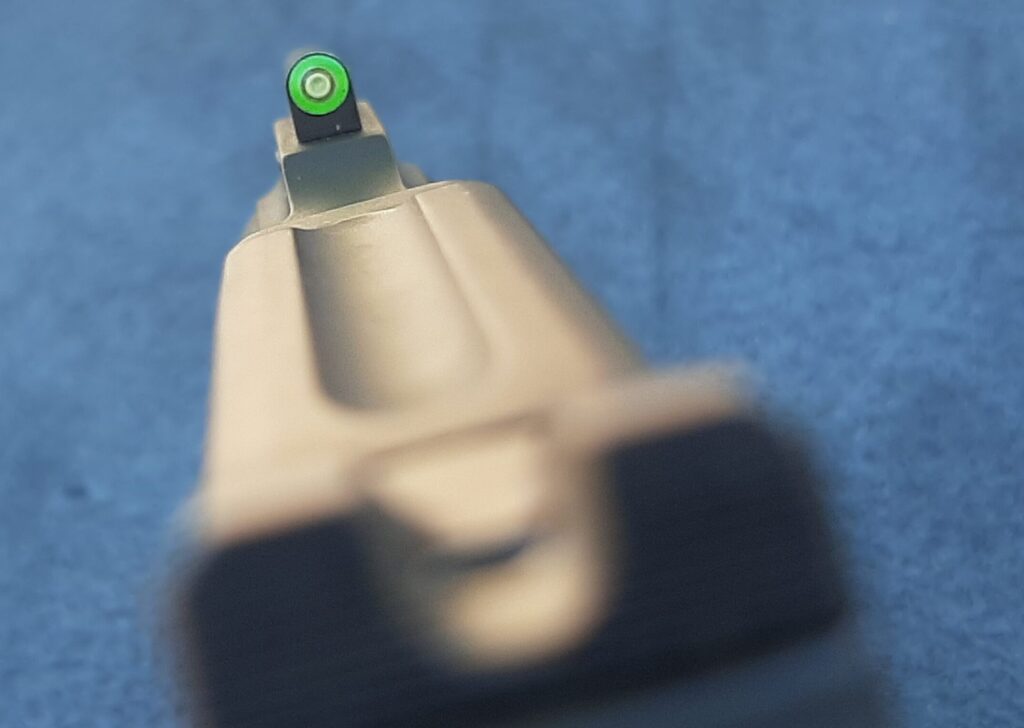
The XS Sights lime green front sight lived up to its advertising for visibility and promised to be quick to acquire with the half-moon rear. The serrations on the S&W rear worked to diffuse glare and the U-Notch provided ample daylight on either side of the front dot.
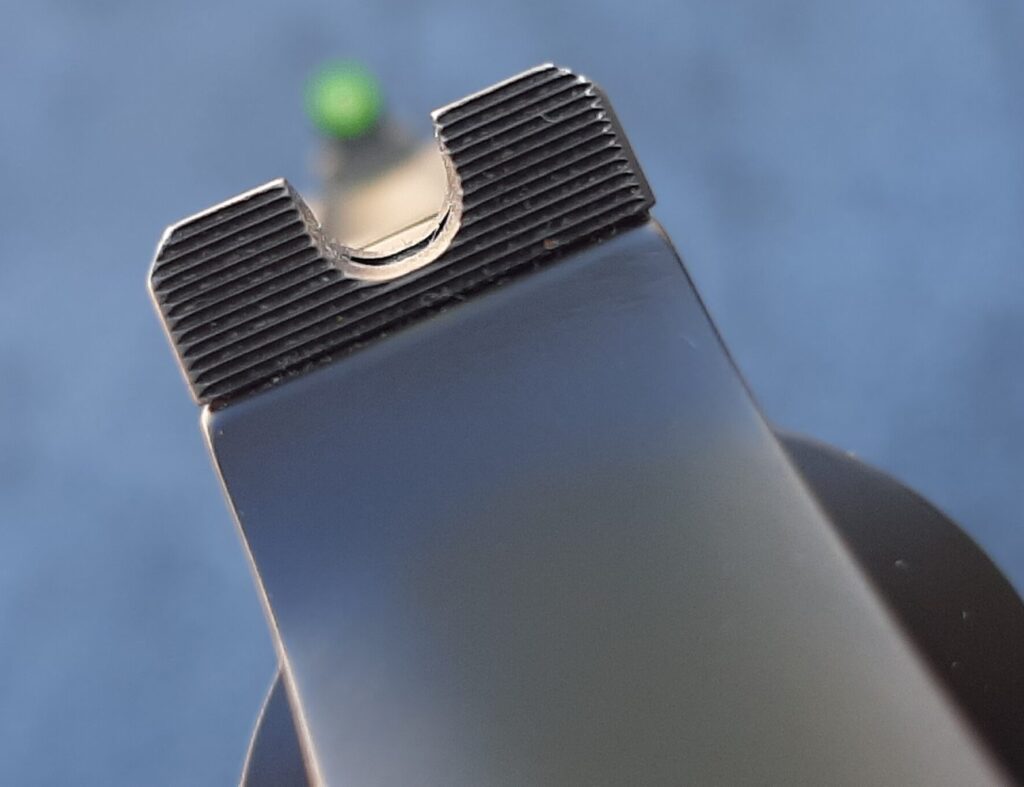
The cylinder had a slight bevel on the flats at the front, just enough to break the sharp edge. The charge holes were chamfered a bit more. That’s a feature I was truly glad that they included.
WORKING WITH THE UC
Fetching some dummy rounds, an HKS 32-J speedloader, and a few 8-round Tuff Products QuickStrips, I went right to work. The chamfer quickly proved its worth with the dry loading reps. The .32 may benefit more from the chamfer than the .38 version because everything is smaller. You must be a little more deliberate in your handling as things get crowded in a J frame cylinder with six holes in it.
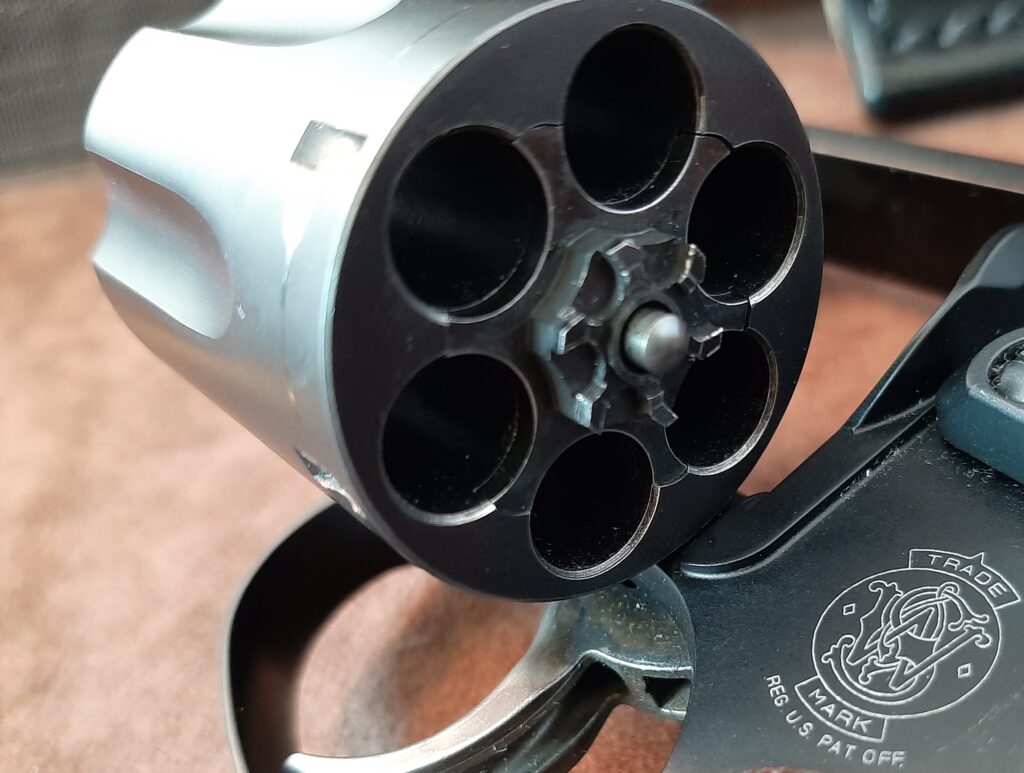
On the plus side, empty .32 cases are shorter than .38 Specials, making it easier to successfully eject them with the J frames diminutive extractor rod. It’s not a huge difference in case length (1.075” vs. 1.155”) but every bit helps.
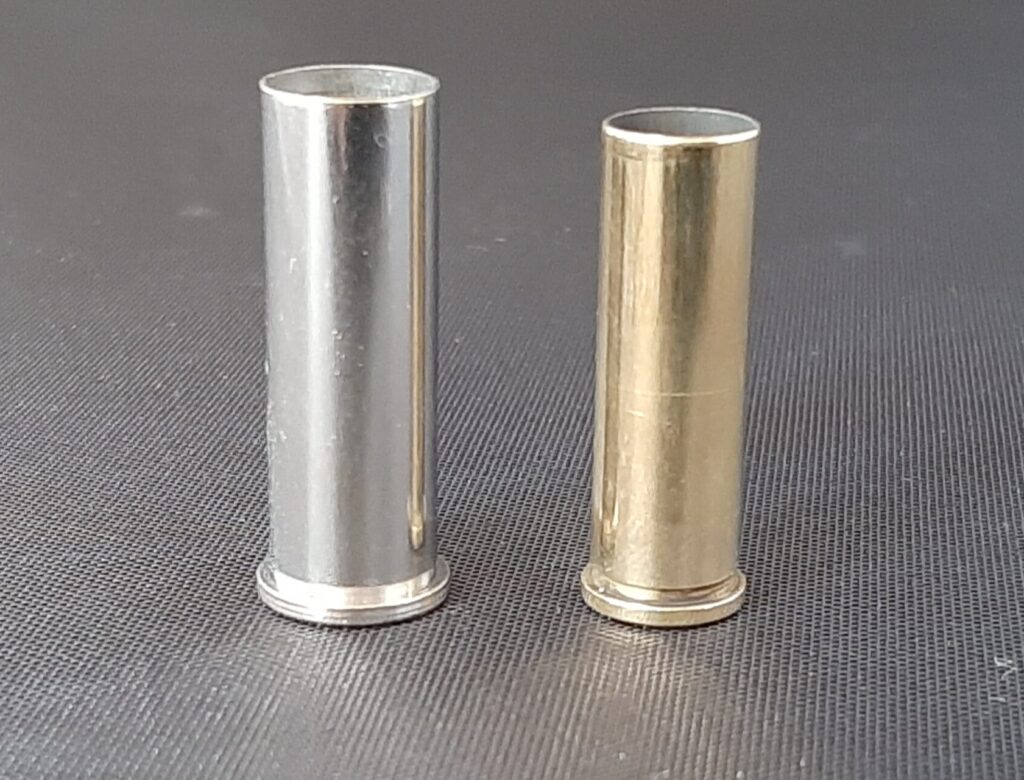
Improving the trigger was one of the primary goals for this project, but I tried not to expect too much before dry firing the gun. The new J frames I’ve handled over the last several years have displayed uniformly stiff trigger pulls. The UC’s trigger was superior to any new J frame I could remember handling, when ran with purpose. Pressing the trigger slowly, it had a definite two stage feel to it. Rolling the trigger made the hitch much less noticeable. It’s not fair to compare it to a 442 that I’d carried and shot for 25 years that had “Black T” applied to its guts by Walter Birdsong in 2001. I dug out an M&P340 of more recent make and ran it a little. It made me appreciate the mojo that S&W engineers put on these UC guns. The trigger on the 432UC is pretty good and I suspect it will get better with wear.
The trigger reset mirrors the feel of the trigger press. Reset was responsive when I came off the trigger sharply. Pinning the trigger rearward and then slowly letting it out made the reset feel like two separate stages. The return felt sluggish when so released, I suspect the lightened rebound slide spring is the culprit- you don’t get something for nothing. For my sample at least, the trigger does well when treated like a fighting gun. Its good to go for its intended purpose.
SHOTS DOWNRANGE
I gathered all the factory ammo I had on hand plus some handloads and a care package of .32 ammo that DoubleTap Ammunition was good enough to send. Mr. McNett and company are repping the .32 H&R Magnum as well as anybody out there right now with three available loadings.
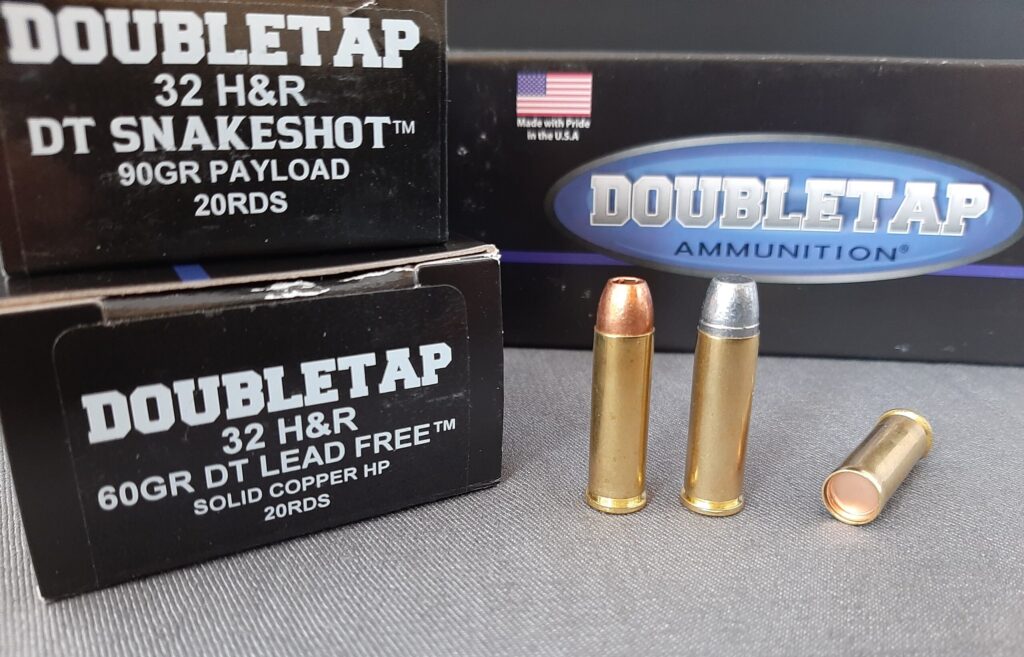
I started out by running everything I brought over the chronograph and shooting offhand groups at 15 yards:
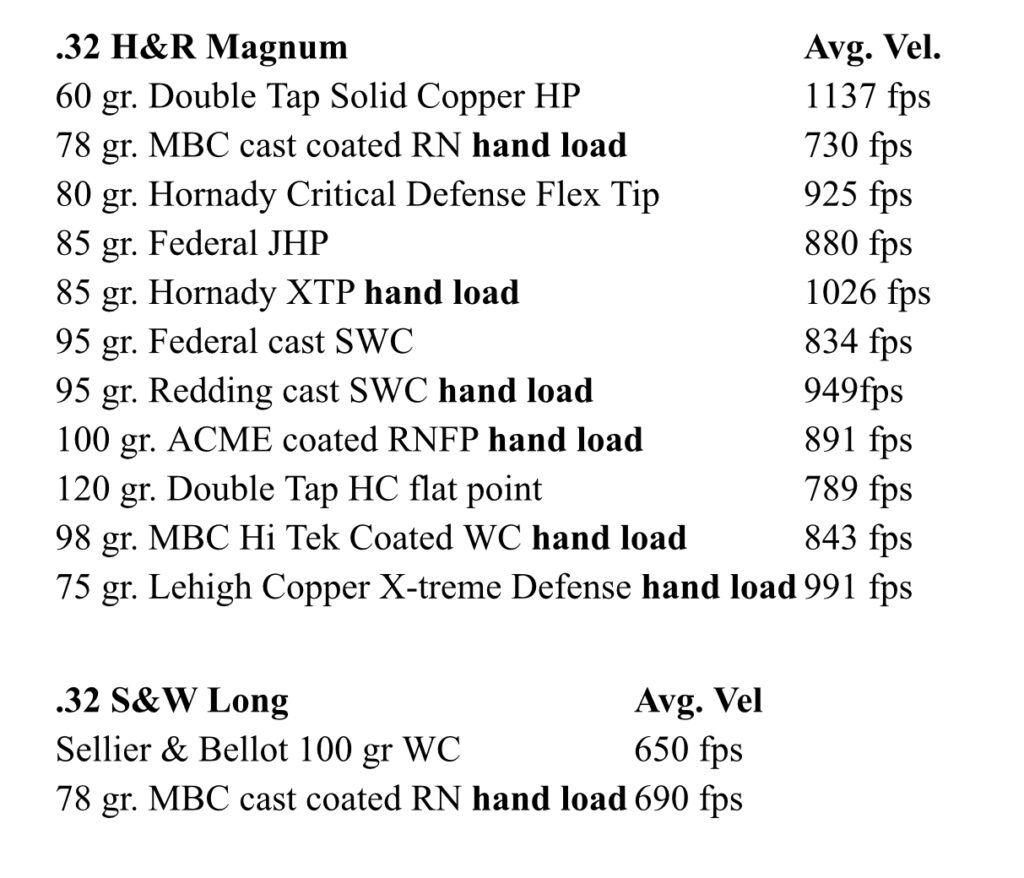
Expecting ping pong ball sized groups from a sub-2” DAO J frame at that range without a rest isn’t completely reasonable. I used a sight picture that had the top of the green orb even with the top of the rear sight blade, like normal pistol sights. This sight arrangement put all but the lightest bullets 2-3 inches high at that range. I used a 6 o’clock hold for the heavier bullets; “base of black” on a B8 target. Most groups would’ve stayed on a baseball, a few went to a softball. One would have needed a small dessert plate; the DoubleTap 60 gr. copper HP canceled that one out with a golf ball sized group at the point of aim (golf clap, DoubleTap). Considering the job description of this gun, its practical accuracy was very good.
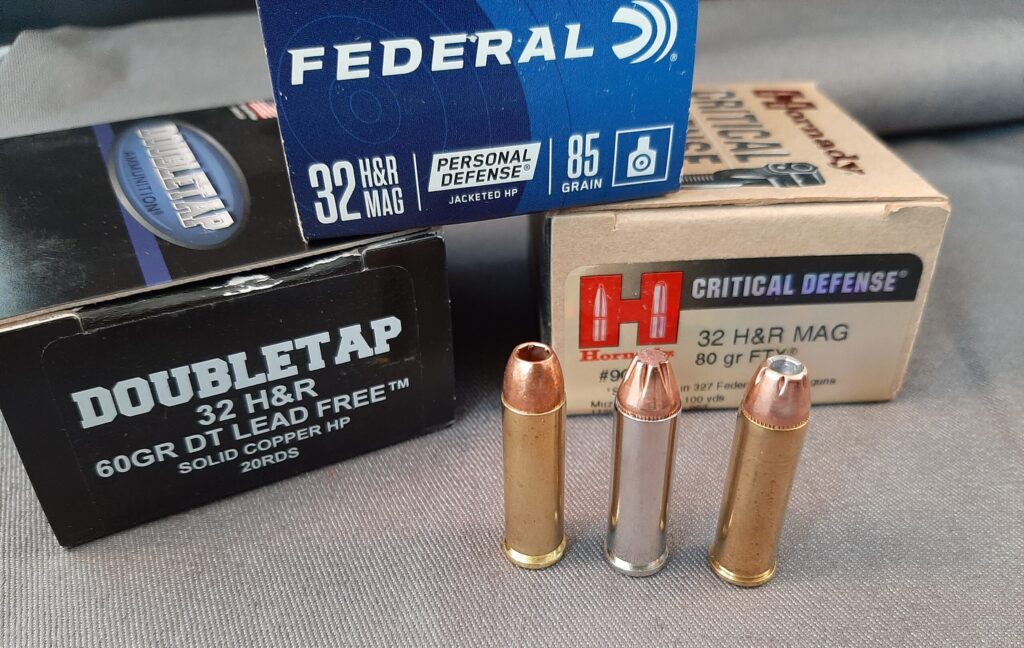
The DoubleTap 60 grain solid copper HP proved to be particularly appealing as a carry load in the 432UC. It impacted to the sights with a conventional sight picture at 15 yards, and the recoil was light even though it generated an impressive 1,137 fps average from the short barrel. Monolithic copper bullets penetrate adequately despite their light for caliber weight. They also expand consistently and reliably when travelling above the minimum velocity threshold for the intended cartridge. The bullet’s rounded ogive lends itself to swift and sure reloading, too- it’s an excellent choice in a compact .32 H&R Magnum revolver. It averaged 13” penetration in clear gel with uniform expansion at the Louisiana Media Day.
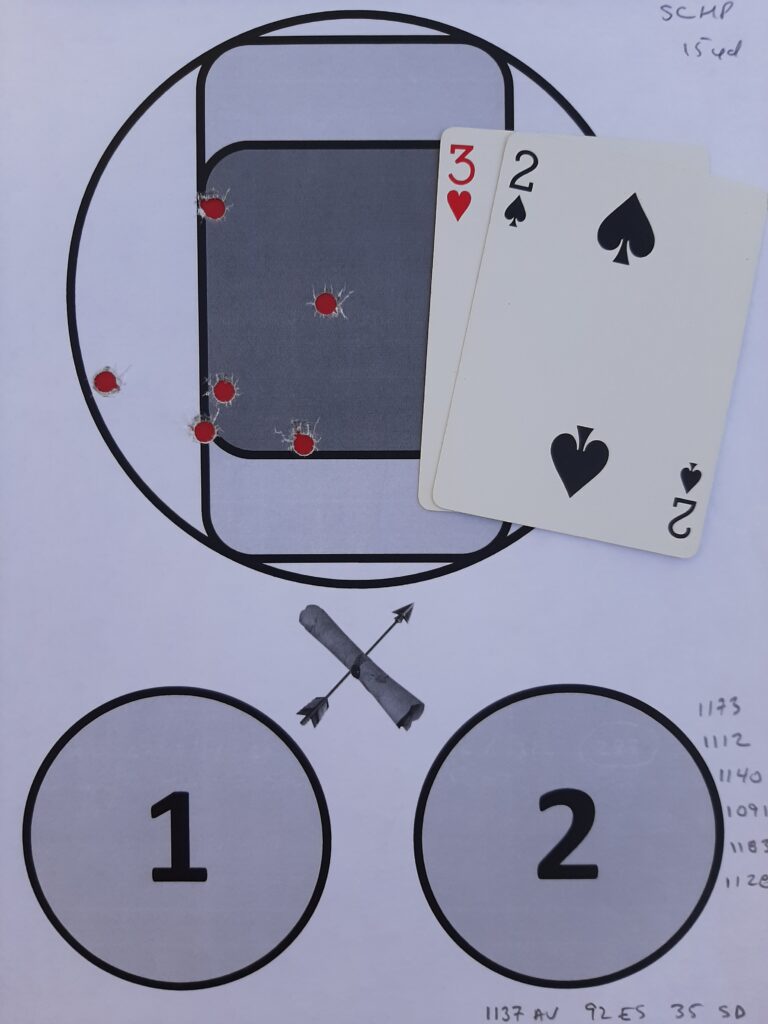
The 80-85 grain bullets (Federal Personal Defense JHP and Hornady Critical Defense) expanded less than the solid copper bullet, but penetrated deeper- 15-17 inches. Recoil was also very light with these rounds. Hornady’s 80 grain FTX averaged 925 fps and hit very close to the point of aim.
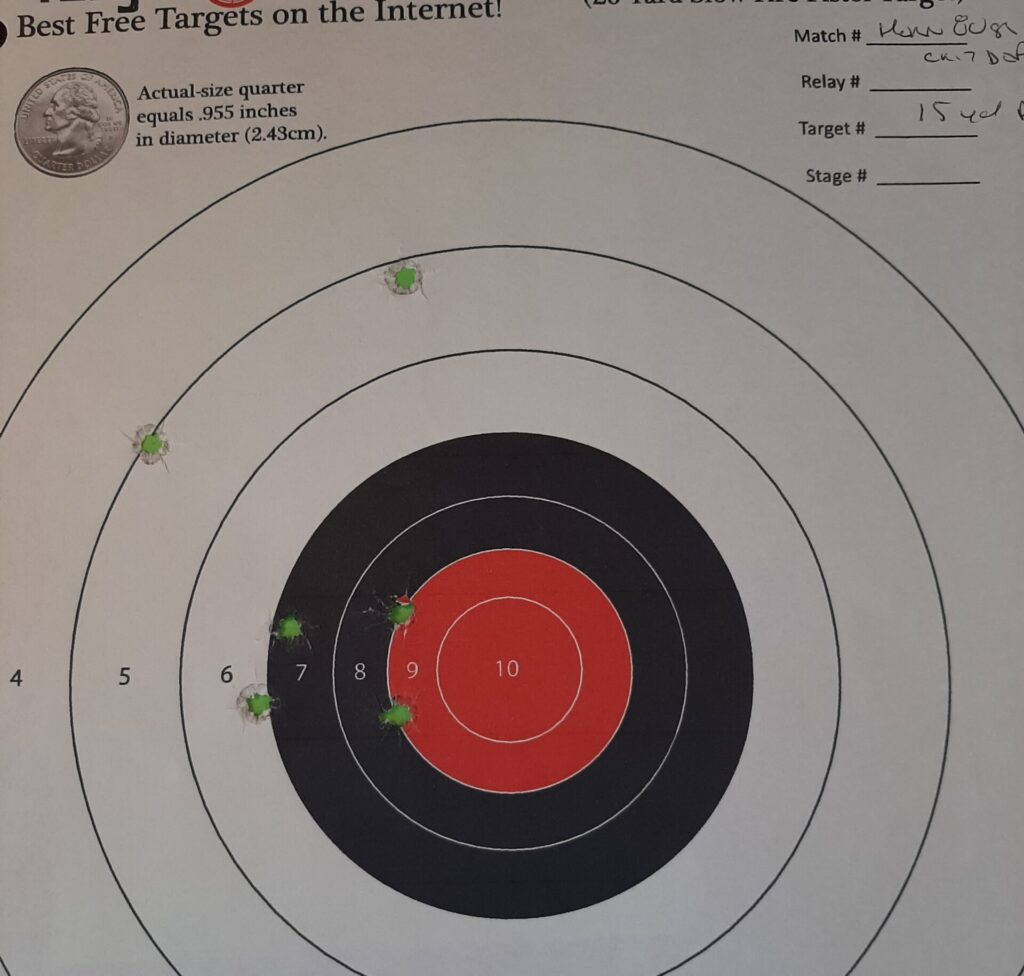
The Federal 85 grain JHP impacted a couple of inches high and averaged 880 Fps. One of the deciding factors in choosing a carry load currently is availability. I exhausted my supply of the Federal 85 gr. JHP and have been unable to replace it. 32 H&R ammo is in short supply locally, and the selection online isn’t much better. I’m hoping that this gun will help upgrade production status for the .32 H&R with manufacturers; and get others on board.
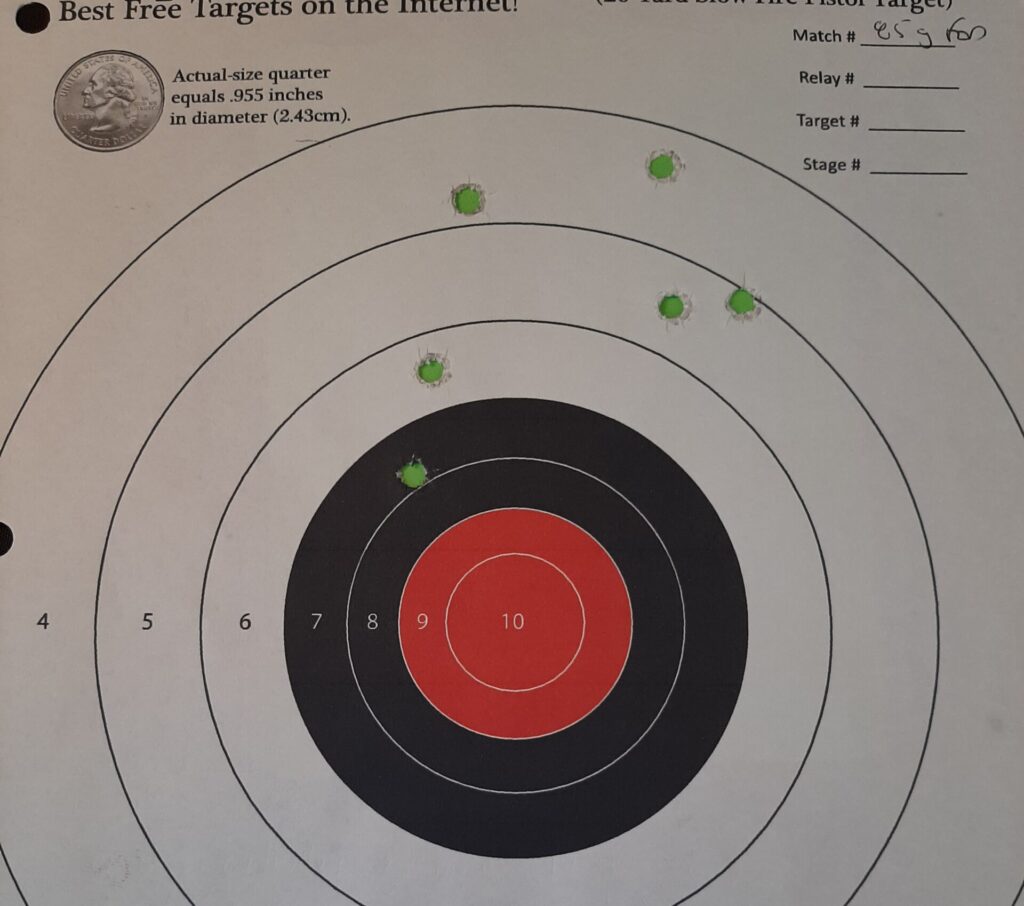
Cast bullets like Lost River Ammunition Company’s wadcutter and DoubleTap’s 120 grain hard cast offer no expansion but plenty of penetration. In a small defensive revolver, deep penetration is preferable to violent expansion that impedes adequate penetration. I didn’t have any of the Lost River 100 grain Poly Coat Wadcutters, which averaged 794 fps at the media day. The DoubleTap heavy hard cast were a little inconsistent from the short barrel and impacted 3-4 inches high of the sights at 15 yards. I suspect powders with a slower burn rate were chosen by DoubleTap envisioning this bullet to be used with longer barreled handguns for hunting.
Several handloads were tested with the UC, a few of which were pushing maximum. The VZ grips were well suited for recoil control; the exception being loads pushing 100 grain bullets above 950 fps. The heavier weight and higher velocity made recoil noticeable. Not punishing, but enough to be unpleasant. Most of the ammo I’ll shoot in this gun will be with 85 grain and lighter bullets, future 100 grain loads will be held to about 900 fps for civility’s sake.
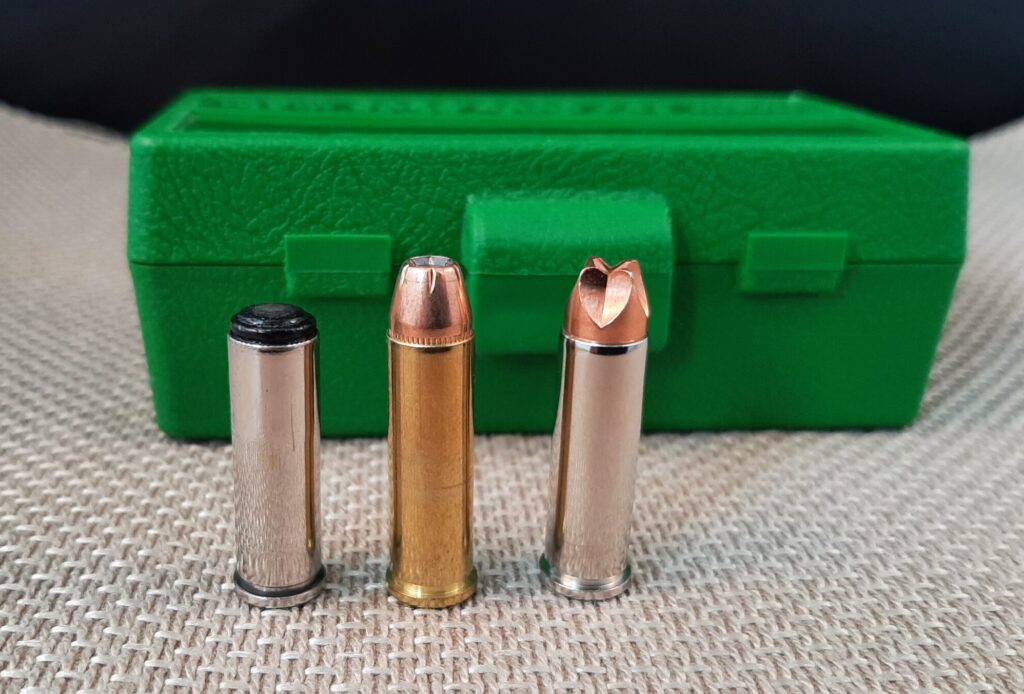
A handload developed for a Ruger LCR pushed Hornady’s 85 gr. XTP to 1,025 fps from the UC. It cracked louder and was snappier than the Federal 85 grain factory load. It shot a little higher and wasn’t as accurate.
Lehigh Defense’s 75 grain solid copper Xtreme Defense bullet showed a lot of potential in the UC’s short barrel. Recoil was reasonable and it hit close to the sights while yielding 990-1,080 fps depending on the powder used. Underwood loads the 95-grain version in the .327 Federal, but I’m unaware of any factory load with the 75-grain bullet in the .32 H&R. It would seem a good candidate for Black Hills to offer in their “Honey Badger” lineup.
I didn’t have any of the Lost River wadcutters, so I ordered some 98 gr. Hi Tek coated .313 wadcutters from the Missouri Bullet Co. to attempt to replicate them. The first attempt had them a little warm at 939 fps with noticeable recoil. The second run gave 776 fps, not quite as fast as desired. Third time was a charm using Hodgdon Universal Clays for an average velocity of 842 fps and hitting basically to the sights.
DIALING THINGS IN
I read Mike’s 3rd installment on the UC revolvers that detailed the media day shooting they did in Louisiana. His diagrams explaining the sight pictures he used made lots of sense and gave me a mission for the next range trip. I started with the “ball in the bucket” technique, lowering the front sight to where the bottom of the green orb nestled into the round bottom of the rear sight. This method was more repeatable for me than a “conventional” sight picture, it was easier to consistently align the round surfaces than the round top front to the flat top rear. It usually produced better groups than using a standard picture and a six o’clock hold.
I found that heavier bullets with higher velocity required the adjusted sight picture, sedate ones not so much. Throwing every conceivable load with every bullet weight available at the 432 makes sense for determining what ammo you ultimately want to run through it. It’s not the best method for establishing a consistent sight picture to use. When you narrow the ammo down, you can settle on how you need to hold the sights.
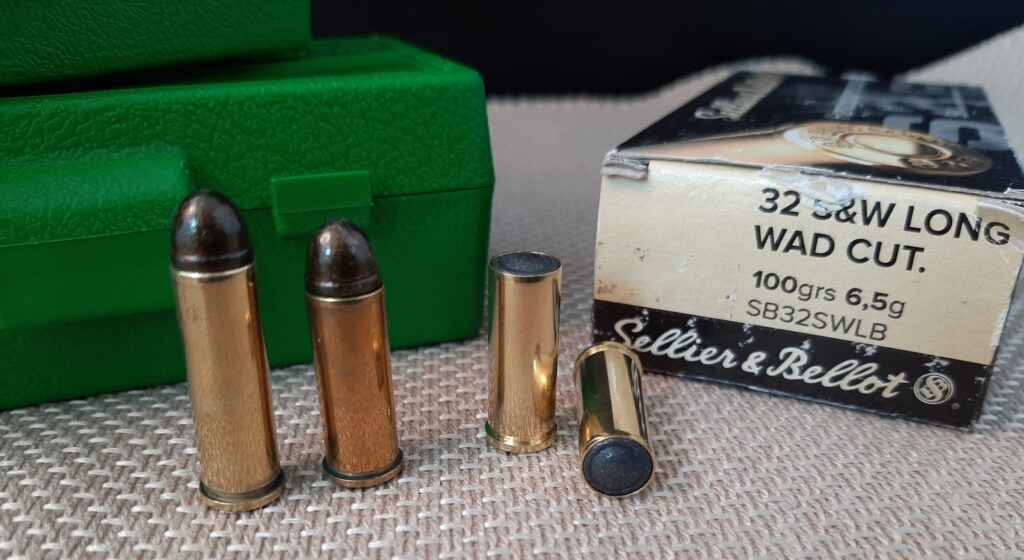
On the next range trip, a pile of .32 Long factory wadcutters and handloads were packed. Sellier & Bellot 100 grain .32 Long wadcutters struck precisely to the point of aim with a conventional sight picture (as intended by the designers) at 15 yards. They ran a leisurely 640 fps but grouped very well from 3-25 yards. A 32 H&R handload with MBC’s 78-grain coated RN and Trail Boss powder shot well with a normal sight picture. I loaded the same bullet in .32 Long cases and was able to get more consistent velocities with a little less powder. Velocity dropped from 730 fps average to 690 fps, but it remained accurate. All the .32 Long loads were incredibly pleasant to shoot and would make great all day practice loads. Because of this, using .32 Longs would also make it infinitely easier to teach J Frame proficiency to new shooters.
A CASE OF MAGNUMITIS
There are those that wish this gun had been chambered in .327 Federal Magnum. There’s a reason that previous J frames chambered in .327 had steel frames. The extra weight (and strength) made those guns tolerable with .327 recoil. S&W probably could’ve made this one from Scandium and chambered it in .327, but the price would have gone way up, and it would suck to shoot with .327 Magnums. It would defeat the whole purpose of chambering it in a .32.
That’s where this gun shines- the light recoil makes it much easier to shoot well and recover quickly if follow up shots are required. The .32 H&R Mag chambering in a gun this weight makes good shot placement more attainable; Hats off to Gore and his team for making it so. Hopefully, the UC guns will be successful enough to convince S&W to bring some .327 revolvers back as well.
PACKING THE 432UC
The 432UC was a dream to carry in a Harry’s Holsters Icon 2.0 AIWB holster. It hid under minimal garments and made all day carry no trouble. Pocketing a QuickStrip and snapping a Simply Rugged Holsters 2X6 pouch on my belt gave two full reloads that were discreet and painless to tote.
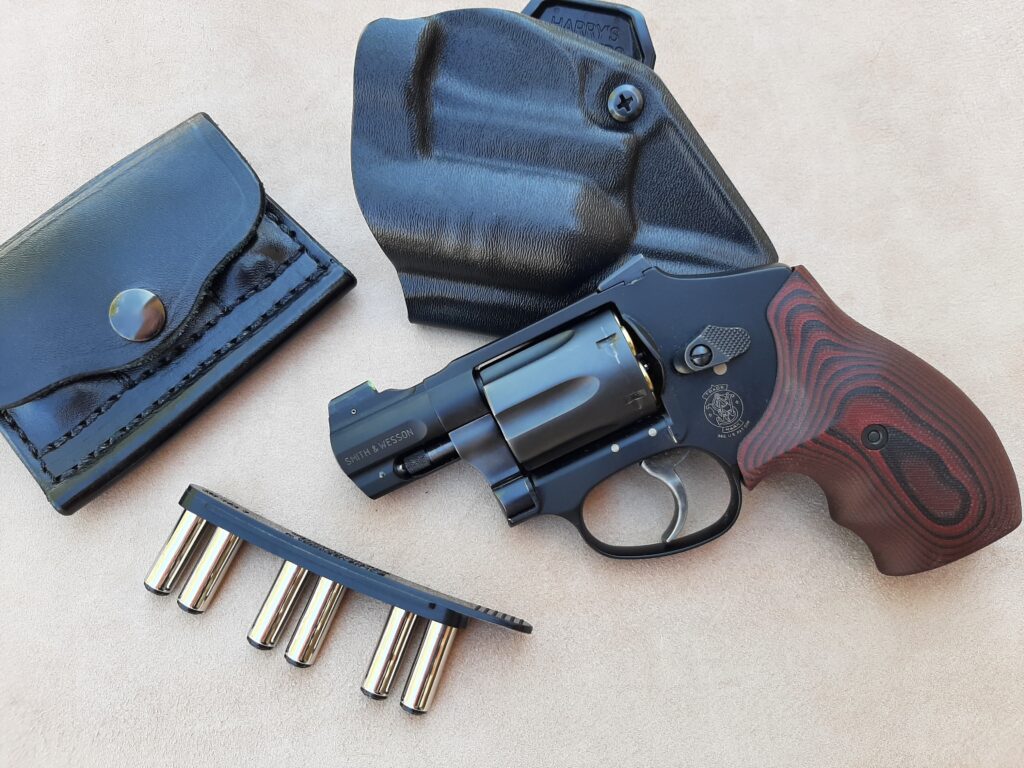
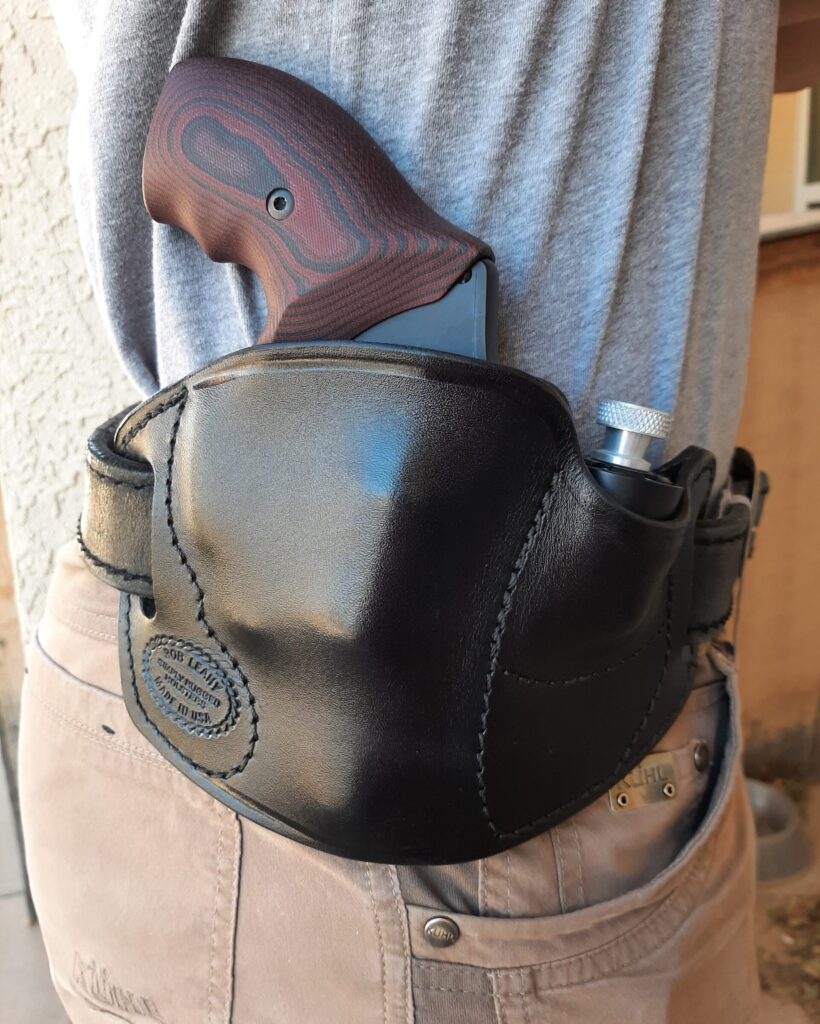
This is where the hammerless alloy J frame and the VZ grips excelled. I wore this combination doing chores and relaxing in the evening after work for many nights. A 32-J speedloader or two could join the ensemble for a trip to town or a walk in the desert.
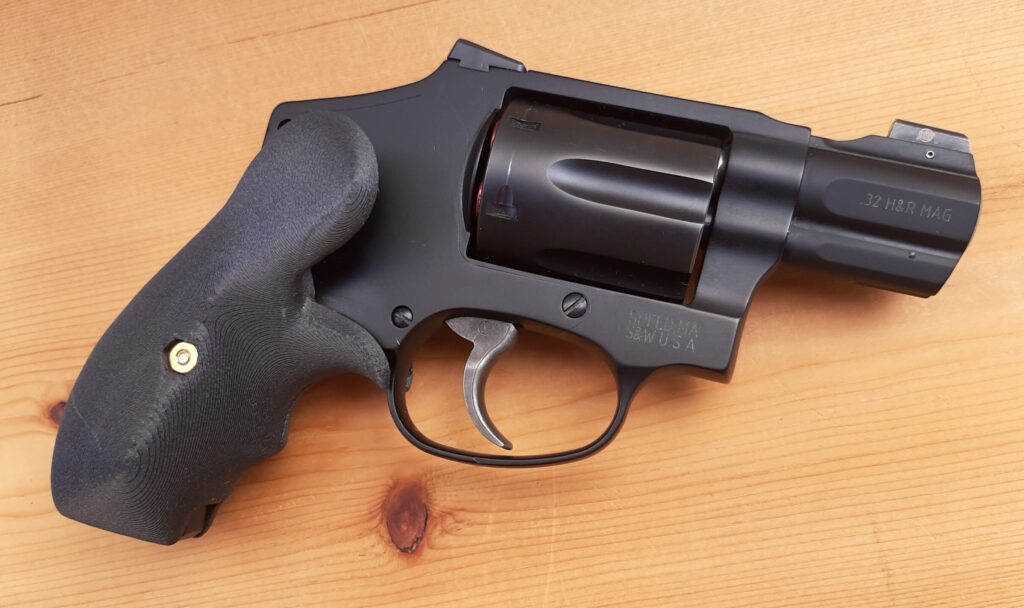
Swapping the VZ grips for a set of Hamre Forge’s “Hamre Hook” grips allows carrying belt and holster free. The Hamre Hook lets you securely carry the UC even while wearing sweatpants or board shorts, it takes away the excuse of “it’s too much trouble” to carry when you are checking the mailbox or whatnot.
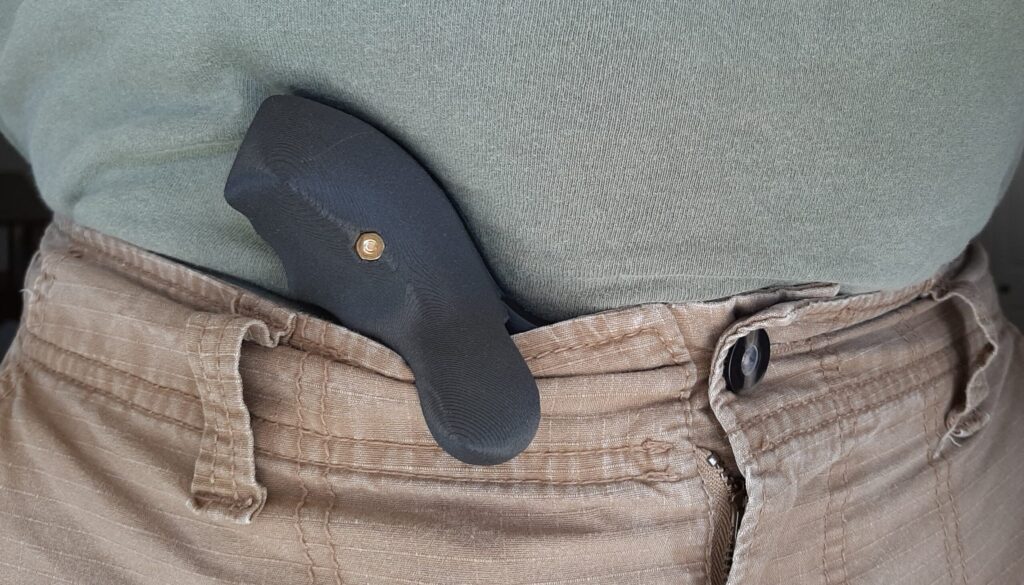
DoubleTap’s .32 Snakeshot load can be subbed in to occupy the first chamber if your evening walk might involve CQB with snakes. That load will take care of business if you end up danger close and must shoot one. The hardcast wadcutter loaded on top of the #9 shot allows the round to still work for bigger critters if needed. It makes prepping for Mr. No Legs a more palatable exercise; you don’t have to completely sacrifice a round of defensive ammunition in a limited capacity revolver.

The black nitride finish worked as advertised and demonstrated excellent resiliency to the sweat bath it often got. This one has been carried next to bare skin or a t-shirt in the brutal heat of a NM summer. Often the gun was wet with sweat when it and its holster were doffed. The VZ’s were purposefully removed at each cleaning; no corrosion or rust was observed underneath.
A WORKOUT WITH THE 432UC
On a hastily planned range trip, I packed a shot timer instead of a chronograph. It had been six weeks since I’d shot the 432 UC, I started by shooting Justin Dyal’s 5 Yard Round Up cold. The time limit is 2.5 seconds per stage. I shot it by stage: (1) 1.93 sec (2) 2.29 sec (3) 2.82 sec & (4) 2.06 sec. Stage 3 is 3 rounds from a strong hand only low ready. One of these shots wouldn’t count, so my final score would’ve been 92/100 (-5). I reshot that stage only and made it in 2.46 seconds. Had I made time originally, my score would have been 97/100.
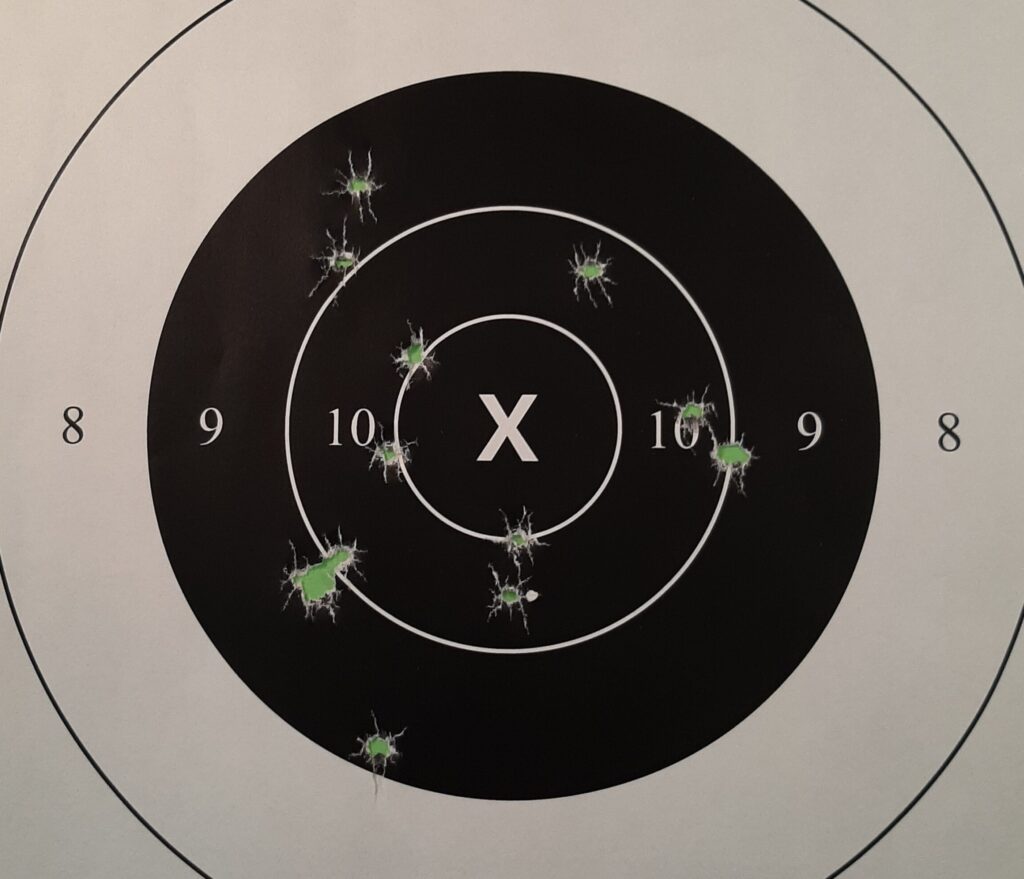
I then fired Wild Bill Hickok’s Gunfighter Challenge that Claude Werner wrote about recently. Six shots onto a 5” square, one of which must impact a 1” square in the center. Firing is strong hand only, no time limit. I confess I failed this sucker the first time out with 2 shots out of the big square. My second attempt was better, but I still missed one. This is a good drill, quite challenging with a snub DAO revolver. Both drills were designed around full-size handguns, the 432UC performed well considering that.
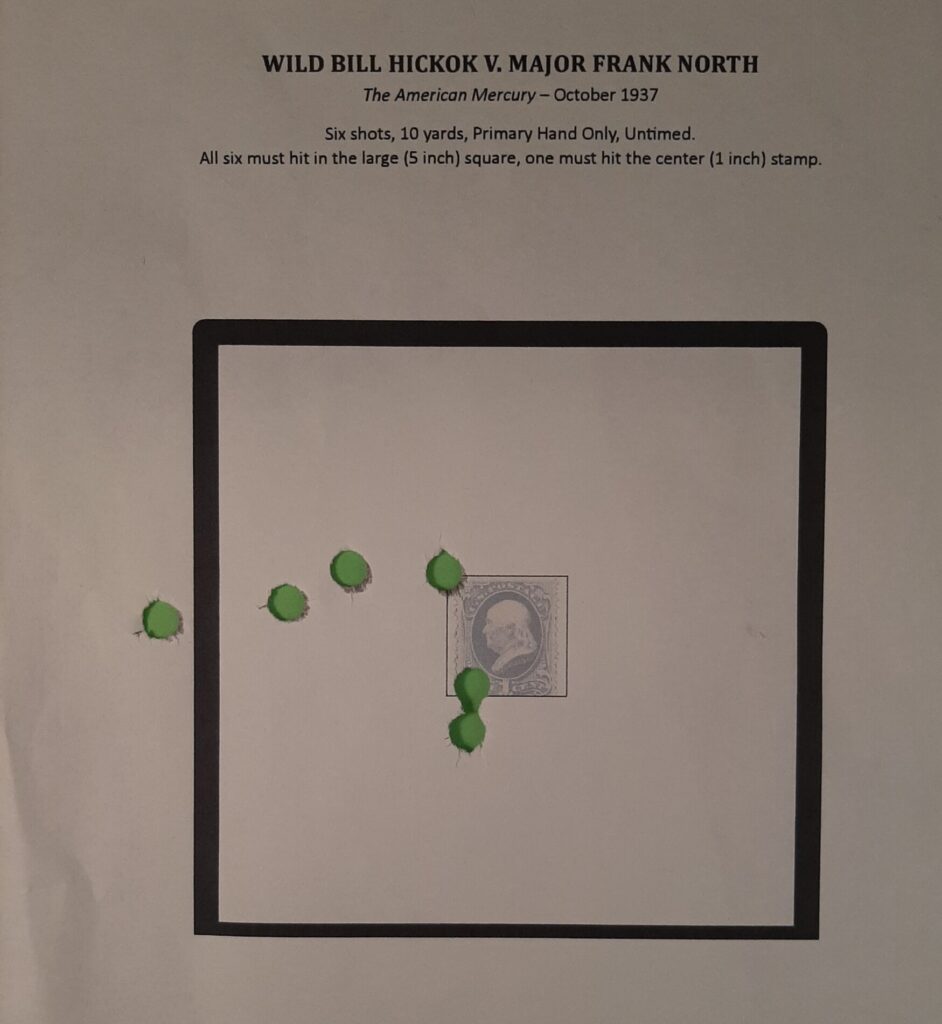
My wife shot the 432UC on this trip and enjoyed it with the .32 Longs. She fired one cylinder of the 32 H&R coated wadcutters loaded to 840 fps and commented that the recoil was unpleasant with them. She’s a good shot, she felt like the gun was shooting a bit left for her. I gave her no instructions on a sight picture, and she shot the light lead RN’s and wadcutters from up close to around 15 yards. She engaged single and multiple targets with controlled pairs and failure drills accurately and quickly with the .32. I asked her how she was using the sights and she said she was lining up the tops of front and rear, like “normal” sights. I finished up shooting pairs and headshots using a flash sight picture. This type of shooting is where the sights, trigger, and caliber of the 432UC let it shine.
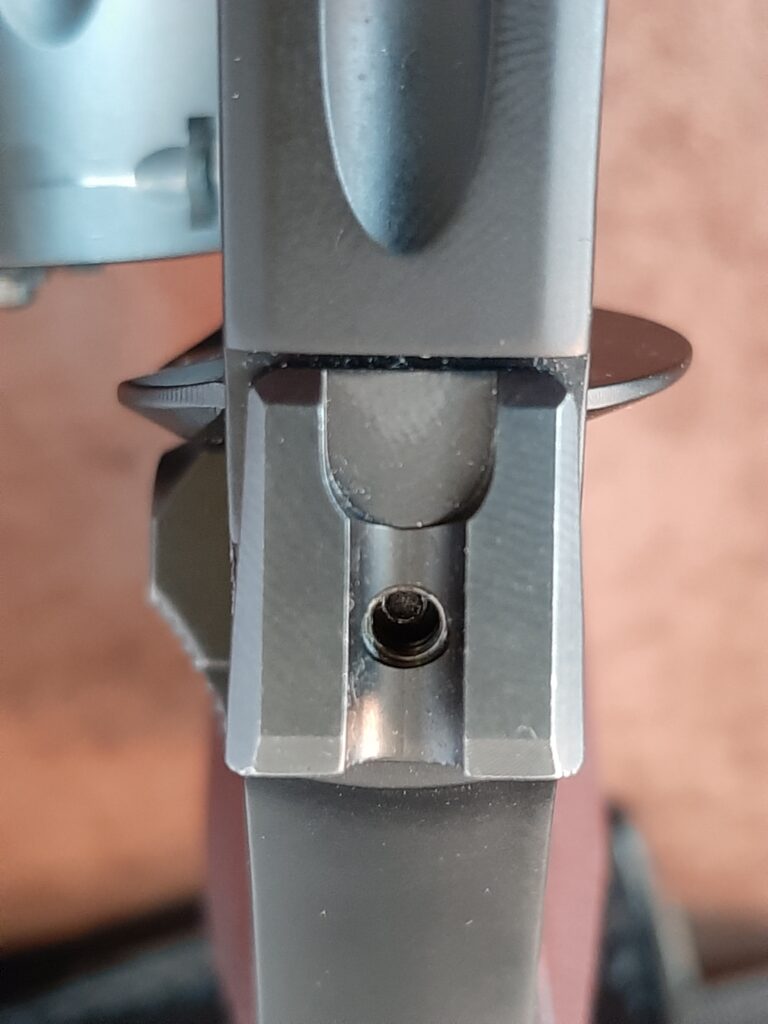
Back at the house, I reviewed all the targets I had saved from the 432 and realized that most of them showed point of impact favoring a bit left (Wives know stuff). It was consistent enough that I decided to move the rear sight slightly to the right, keeping it within the confines of the dovetail. The UC guns allow for a little windage correction with the rear sight, a nice benefit to the system used (I plan on shooting that Gunfighter Challenge again next time out to confirm the adjustment). My sample made it out of the factory without a set screw in the rear sight. The sight was snug enough in the dovetail that I didn’t notice this until I went to move it. Other than that, the quality control on this gun has been quite acceptable. This one has fired 360 rounds to date with no drama, I’ll keep you posted on its durability.
WRAP UP
In summary, the 432UC is easier to shoot fast and recover with than one in .38 Special. The .32 chambering makes it non-punishing and lends to one’s ability to deliver needed accuracy. It’s nice to put 100 rounds through a small light revolver at one setting without your shooting hand stiffening up afterwards. The sights are superior to almost any seen on a J frame, the trigger is good. The retail price asked for the features included is fair, and the internal lock that could affect reliability is gone.
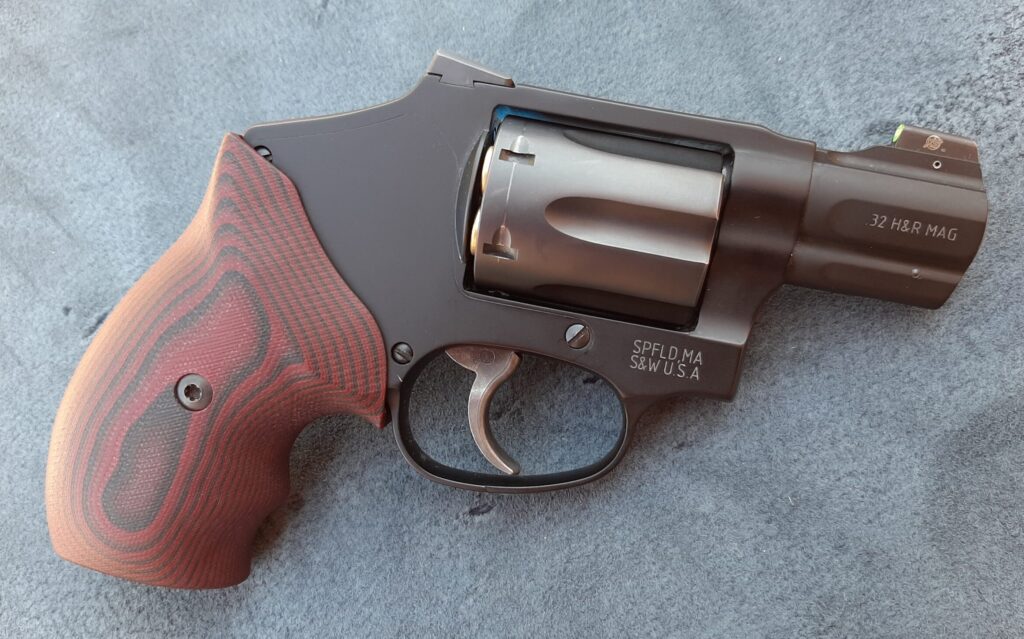
The UC project demonstrates what can happen when management listens to good ideas from end users and teams up with industry leaders (XS sights, VZ grips). Allowing the engineers to clean up identified issues and make needed upgrades was a good thing, too. The collaboration resulted in an efficient and effective carry gun for shooters of all skill and experience levels. The sixth round in the cylinder is a welcome bonus. This revolver was a long time coming- thanks to Lipsey’s and S&W for making it happen.

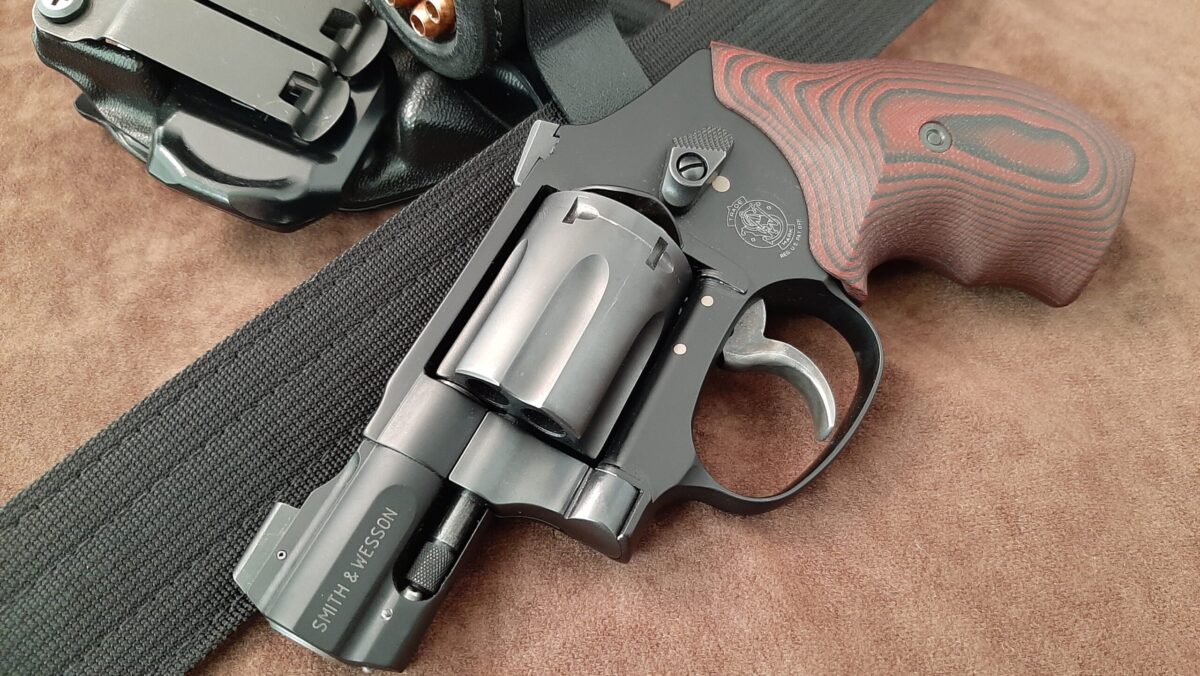
I hope these UC revolvers spur continued interest in the .32H&R. Lipsey’s released a .32 H&R model of the Ruger LCR a month or so ago. That’s something I’m hoping to get, as the LCR is noticeably less expensive than the UC J-Frames.
Also, Steinel makes 85gr and 100gr JHP loads for .32 H&R. The 85gr is my carry load in my Taurus 327.
I hope they do too, Axel. That .32 LCR is a neat add- it shaves ounces off of the steel framed 327 LCR’s weight at 13.9 ounces for the .32. If you only plan on running .32 H&R, it makes sense. I’m only seeing a 20.00 difference in the retail price of it and the UC, maybe real-world pricing is different in your AO?
Thanks for the info on Steinel, I will have to check it out!
Thank you, Kevin, for this comprehensive, detailed and informative end-user review.
Do you think a flat-topped front sight with a “standard” sized tritium sight would have solved, or at least simplified, the sighting issues?
De nada, ViejoLobo. Thanks for reading it. I think a flat top sight of more traditional proportions would have been easier to line up with a conventional sight picture, yes. If it happened to zero with your chosen defense bullet weight, that would be really handy. That doesn’t seem to always be the case (S&W 640 Pro Series, Kimber K6) though. The way you place the dot in the rear with these gives more options for bullet weights, and a method can be settled on with a chosen load, so it’s not that big of a deal. The advantage these sights give towards acquiring them quickly and in poor light (ESPECIALLY with older eyes) is worth the trade off, I think.
Great article. Any idea if the UCs will be added to the California handgun roster?
Pete, my contact at S&W advises they have been submitted and they expect the guns to be on the CA Roster by the end of March!
Thanks Mike. That’s great news!
Hey Mike – the UCs have been added to the roster!
Great news, Pete, thanks! I looked this morning, but didn’t see them yet. Thanks for the update!
Having an additional round of .32 H&R in the cylinder instead of the standard five-shot.38 J frames is a great option. If Smith offered a 432UC in .22 Magnum that would be neat, too. Maybe it could be a 7- or 8-round snubby.
Hey Spencer, that would be a neat addition. Smith’s 351C could be given the UC treatment pretty easily, I would think. Based on that model, I would think the J frame cylinder would be a 7 rounder. The rimfire cartridge might limit how much they could lighten the trigger, but the UC package would be a great upgrade to a very useful little gun. Hornady and Speer have brought out defensive loadings designed for short barrels in the .22 WMR that make a good case for the rimfire as a “Rule One Gun”. You are in good company as an advocate of this concept (Bolke, Ellifritz) and I hope S&W listens to you!
Those are excellent ideas regarding .22 Magnums, Kevin. Over many years, I’ve owned rimfires in .22 Magnum and they all had decent triggers out of the box. So, there was never any reason for me to mess with the main and trigger springs.
It would be impossible for me to accurately state the number of .22 LR ammo duds I’ve experienced in my lifetime, but probably hundreds. Yet I never have had a .22 Magnum not detonate. People who know a lot more about ammo than I claim the Magnum fodder is made with greater care and therefore justifies its price.
Spencer, I confess I lumped all rimfire rounds together in my thinking. I helped to thin out marauding jack rabbit herds and depopulated many a prairie dog town in my youth with .22 Mag rifles, but I don’t have many .22 Magnums down range from handguns. I would nearly always opt for the .22lr cylinder in the convertible Single Six for fiscal reasons. I can’t speak from a position of much experience with .22 Mag D/A revolvers, but you have made me think I should remedy that. I don’t recall a .22 Mag ever failing to ignite, either. I’ll start on my homework soonest!
Oh man, you guys have planted the ‘351 UC’ idea in my head and it’s haunting me. I love my 642 UC and my 351C, and a marriage of the two would be really sweet.
And Spencer – my experience mirrors yours. I have found .22 WMR to be very reliable.
Hammer, I’m going to blame this all on Spencer. 🙂 I’m glad you guys have both found the .22 Mag more reliably igniting than the .22 LR. I’m hoping my wife will accept the “but it’s for scientific experimentation” reason if I invest in a .22 Mag snub…
Kevin, your evaluation parallels my experience, though more of my testing has involved 32 Longs. The 432 UC is a well-designed little gat incorporating a lot of deep thinking. It has completely displaced my 642 for EDC pocket carry. The 32 H&R LCR is neat too. Hope to convince our range to add one to the rental lineup. Time for Taurus, Colt, and Kimber to take a crack at a lightweight 32 H&R.
Thats good to know, Michael. The .32 Long has a long history of underrated capability and this .32 “renaissance” is helping to showcase it as well as the .32 H&R. A .32 L wadcutter can be shot swiftly and accurately by most shooters… The six shot .32 caliber J frame sized gun fills a needed niche, no doubt. The S&W J frame UC has done a good job tapping into that and displaced many .38’s in the role of EDC, I would bet. You point out that the UC is a ‘thinking man’s (or woman’s) EDC revolver; that’s a good description. Charter Arms has done well to remember the .32 H&R in their lineup, I’d love to see the good folks at Colt, Kimber, and Taurus add to the mix!
Thank you Kevin, for another world class review. If the article circulates like I hope it does it will bring more converts to the good sense of the .32 magnum. And hopefully a significant increase in ammo production.
My interest in the .32 mag started around 1984 with the Ruger Single Six. I liked it a lot. At the time I was deep in the cult of the .44 Special. Little did I know that life changes would later cement my affection for the .32. When Smith brought out the 631 around 1990 with that extra round in a J frame I swallowed the hook.
The life change started about 10 or 12 years ago. I started noticing that I was not as keen on recoil as I once was. My hands hurt all of a sudden The .44 Specials left, sorry Skeeter, and the .32 took their place. 150% in agreement , no .327 magnums in J frames.
Thanks to all the folks who had a hand in doing so much too bring more .32s and to start the demise of the Clinton Cavities
from Smith.
Stay safe all.
Tony
You’re welcome, Tony. You’ve been a long-time flag bearer for the .32, and I agree the 432 and 632 UC’s should help sell it. It sounds like ammo companies are starting to take notice: Federal is adding a few loadings this year and we have smaller outfits like High Desert Cartridge and Lost River producing practical ammo, too. I shot lots of 32 Mag stuff today and, what do you know, my shooting hand doesn’t hurt! The .32 Mag does make good sense. S&W seems like they are warming up to building new guns without the internal lock, and you rightly credit folks on the UC project with helping to make that happen. 2025 looks like it may be a good year for us!
I purchased a 432 UC a few weeks ago and have only shot fifty rounds through it st an indoor range. It is so much easier to shoot than my .38 caliber airweight. I used PPU 98 grain, very soft but using a traditional sight picture it was two inches low at five yards. I will buy some other ammo shortly and test it. In March I am scheduled to attended a one day revolver class and want to use this. I really like this little guy.
Hey Bruce, there’s a noticeable difference in recoil between the .32 and nearly all .38’s. shooting .32 Longs (like the 98 gr. PPU you found) makes the difference even more stark. I’m confident you will find ammo and a sight picture that will allow rounds to impact to your point of aim. Good luck in March!
I purchased a 632UC as soon as I could get one. Although I really like this revolver, my sample did not live up to the hype when it comes to the DA trigger pull. I haven’t weighed it, but it feels like at least 15 pounds or perhaps more. I went as far as installing an Apex spring kit in the revolver, but the lighter mainspring produced fairly regular misfires. I put the original back in for 100% reliability.
.32 H&R ammunition is pretty rare around here and expensive when it can be found, so bought a set of Lee dies and 1000 Starline cases. I worked up a carry load with H-110 that chronographs 900 fps with the Hornady 100-grain XTP, and a practice load with Red Dot that does 750 fps with a 100-grain hard cast SWC.
My revolver shot significantly low and left of POA when I received it. I had to drift the rear sight as far left as possible without having it protrude beyond the frame to bring the windage to center, but only a higher rear sight (or a lower front sight) could cure the elevation problem. I try to consciously hold the front sight noticeably higher than the rear to bring POA and POI together.
I found that a Tuff Products small Tactical Pouch will hold two 6-round Tuff Strips in .32 (but only one in .38). I stick an 8-shot Tuff Strip in my pocket and am able to comfortably carry a total of 26 rounds of .32 H&R on my person. Not bad for a snubby.
My 632UC is a great gun and I like carrying it, but it has the heaviest DA pull of any J-Frame I have ever owned, which is disappointing to me, considering it’s supposed “lightened” trigger pull.
Robert, if you’re right handed, the low and left impacts are probably related to your struggle with the heavy trigger, not a sight issue. You might consider contacting S&W Customer Service about the heavy action, as your gun shouldn’t be 15+ pounds in pull weight. Have you actually measured it?
It’s a sight issue for sure. I have a great deal of experience with S&W DA’s in J, K, L and N frame sizes. I haven’t weighed the trigger because my set of trigger weights from S&W Revolver Armorer’s School isn’t heavy enough and I am too cheap to buy another gauge. I have thought about contacting S&W about it, but frankly I shoot it well enough as is that I am not a highly motivated problem customer.
S&W Customer Service will correct the issues so you don’t have to rely on drifted sights and floating fronts. As you surely understand, those methods work well enough for recreational purposes, but if you’re planning to use the gun for more serious pursuits, it needs to hit where it’s pointed.
That advice extends to all the members of our audience. We’ve heard a number of complaints about sights and triggers from readers since the UCs were released, and we’d encourage all of you to send them back if you’re dissatisfied in any way. Don’t live with it, fix it!
S&W’s warranty return numbers on the UCs look excellent, but we’re reinforcing sloppy work if we hide the true judgment on their manufacturing process by eating the flaws we discover. There will be no motivation to fix things unless there are sufficient returns. Silence abets poor work in Springfield.
Hey Robert, that trigger pull is disappointing. I’m with Mike, S&W should remedy that trigger pull if you send it back. I would also mention the sight issue to them, it’s not out of the question that your gun got the wrong height front or rear sight. You might have gotten a gun assembled on Friday afternoon… I really hope they will make it right for you! Thumbs up to your carry and practice loads, and hopefully .32 Mag will flow more freely soon with the popularity of these guns. Thats another benefit of the smaller caliber that you sagely mention- it’s easier to carry more ammo. good luck!
Oops! I drifted the rear sight to the right…
Thanks for the references to the two tests. I had already marked the Roundup, just haven’t shot it yet. The Hickok test was new to me and I’ll use it next time I go to the range.
Also thanks for the Simply Rugged Boomer holster reference. I think I’ll order one and see how well it works. It looks like a very good idea.
I couldn’t find the Hamre Hook on the Hamre Forge website, is it TBA?
Finally some more sweet Lipsey news on YouTube, released 20 hours ago:
Lipsey’s Exclusive: Smith & Wesson No Lock 686 and 629 Mountain Guns
This looks like the beginning of a beautiful relationship.
Gregory, the hook is an optional feature you select from a dropdown menu on the page for a particular Hamre Forge grip design. For example, on the J-Frame Spegel grip page, you can select “hooked” from the dropown menu if you want a panel with the hook (or “Standard” if you don’t, or “Full Set” for both)
RevolverGuy has been included in the new Mountain Gun project from the start, and you’ll see some coverage of them in these pages soon.
You’re welcome, Gregory. Hickok’s test is sporty with a 2″ J frame, so don’t get discouraged if you don’t clean it first time out. The Boomer is an exceptional rig if you favor OWB carry and having that speedloader right there is really handy. Typical Rob Leahy quality and ingenuity. It wears comfortably, hides well, and gives a clean presentation. I woke up to that great news on the Mountain Guns yesterday, too. That made me smile from ear to ear. Way to go, Lipsey’s, and thanks S&W! I’m looking forward to both of these, big time!
Kevin, you should be the dedicated .32 caliber revolver evangelist ! Excellent writeup. Considering the extreme SAAMI pressure differences between the .32 H&R and the .327 Federal, one has to ponder whether a .32 H&R “+P” might be feasible to allow for an even broader range of load performance.
Being a full wadcutter fan, a wadcutter or even a Keith style semi wadcutter, would give the .32 caliber class a very effective leap in defensive utility. For those with smaller hands, those who are recoil sensitive, or those who just want something small and light, this would be just about perfect.
I jumped on the 432 UC bandwagon in part because I’m battling arthritis in both hands, so I haven’t tried any of Buffalo Bore’s Heavy 32 H&R Magnum +P Outdoorsman loads yet. I suspect a 130 gr. Hard Cast Keith @ 1125fps ought to scratch the “I need more power” itch…
In the meantime S&B 32 Long wadcutters feel closer to 22 than 38 recoil-wise, while meeting FBI penetration specs on gel. The Lost River and High Desert wadcutters are peppier and go 18-20 inches in 4LD gel tests, but they’re still pleasant, easy to control, and quick to shoot.
The wadcutters you listed will cover most of the chores needed from a gun like this, Michael. Those S&B .32 Long wadcutters are pure enjoyment. I just shot some of the High Desert coated 98 gr. WC’s, they ran 832 fps from a 3″-barrel and were very accurate. Viva la Wadcutter!
Hah! Thanks, S. Bond! Not sure I’m worthy of the title, but I’ll take it! Thats a compelling point you raise on the wide range between top of SAAMI on the .32 and the pressure window of the .327 Federal. I was loading some 100 grain Hornady XTP’s on top of Accurate Arms #9 recently with data from Brian Pearce from Handloader magazine. The hottest loads he used he listed as “+P, for use in Ruger and S&W guns only”. They were loaded at higher than SAAMI standard but safe in strong guns. He published some loads that would safely propel the XTP to 1000- 1050 fps from a 2″ J frame. That dude is Yoda in a cowboy hat when it comes to handloading six-guns, I trust his counsel. As you point out, a blunt faced cast bullet will give deep penetration- even at low velocities. They’re a great choice in the .32 H&R (and .32 Long for that matter) for defensive use. Rock on!
S. Bond, I neglected to mention that Buffalo Bore already markets two “Heavy +P” loadings for the .32H&R Magnum. One with the 100 gr. XTP JHP: 1187 fps from a 3″ Ruger SP101, 1054 fps from a 2″ Taurus. The other is a 130gr. Keith SWC @1133 fps from the 3″Ruger. Good stuff!
Outstanding review Sir! I dont personally have any experience with the .32 but I can say my experience with the 442 UC has been similar as far as trying different ammo and sight pictures. I realized very quickly though, regardless of ammo selection, the ability to pick up the sights better allows for “effective” hits on target even if the group is a little high or low. I have tried every weight of bullet I had in my supply, including heavier 158s that the sights were not technically set up for. I really love my UC and have no complaints. It truly is a daily companion for me.
Thank you, Mark! You touch on one of the biggest advantages of the UC series in both calibers: the sights are easy to see and greatly aid in getting decent hits rapidly. S&W and XS Sights executed the design very well to comply with the wishes of the Lipsey’s team. They are well suited to the way you use the gun. Good stuff!
My local gun shop finally got its first 32UC in stock in December (632UC), and I was there the day it was put into the case. I’ve been stocking up on some 32 ammo and a couple of HKS 32 speedloaders, figuring I’d pick one up when they were in good distribution to the regular gun store buyer. The clerk and I could barely open the cylinder and, when we did, you could see the groove the extractor rod was furrowing into the back of the cylinder wall on the frame as we tried it a couple of times. Took the wind out of my sails. They sent it back for repair, of course, but someone else can buy it. Kind of a sad statement on QA, especially for that halo gun and at that price point. (And I’m an S&W J-frame fanboy, carry one every day as a “minimum” gun)
Ugh. That’s awful, Bill.
Yes, the QC has been an issue on some of these. Buyers will need to pay close attention, and be willing to call Customer Service to correct any issues that crop up.
A good sample is a great gun, but some of the guns slipping out of Springfield are unacceptable.
Kevin
Thanks for the detailed review. I have a few 32’s. We use them on trapline and for dispatching pests.
The UC J frames are quite and improvement over the model 31’s and the 32 Hand Ejector.
The sights on the UC are simply superb. I use the ball in bucket technique and am pleased with the results.
My 432 UC is darned near perfect. Timing is excellent. It shoots to sights. Can’t ask for much more. This revolver was a much appreciated gift.
My 632 UC is not the same quality as the 432. The 632 timing is off quite a bit – too advanced so that the cylinder stop slams into the cylinder stop notch. It has been back to S&W with no resolution. It is “within specifications.” Sad. Best I can tell is that the hand is a bit long. Eventually I’ll take it apart and tune it up. For now it works for purpose.
This timing issue seems very common on current production stainless revolvers. I have had similar troubles with two 627 PC guns that are ICORE toys. Both required new ratchets installed by my local mechanic. Smith declined to fix them. Note to the QC folks: timing revolvers is fairly important to folks who actually shoot them.
That said, the UC treatment is a wonderful improvement that should be applied to all fixed sight revolvers. Anxiously waiting the revived model 12 UC
You bet, John. I know where you’re coming from on the drastic difference in the sights on a Model 31 and the 432UC- literally like night and day! I hate to hear that about your 632UC, and your pair of PC 627’s. Interesting that stainless guns seem to be more afflicted… You obviously use your guns and know your way around them. If I were running S&W Customer Service, I would call you personally and try to remedy the issues with your guns. “Timing revolvers is fairly important to folks who actually shoot them.” You spoke a mouthful of truth there, Sir! I would sure like to see a tighter effort from the QC folks, S&W’s revolver reputation is largely in their hands. The revolver market is increasing, there are good guns appearing from other makers. Hopefully S&W will increase their efforts to build them solid (the first time!) and keep earning the loyalty of longtime customers. I’m with you 100% on that Model 12 UC!
Yes sir, a very good review, thank you. I know you had to dedicate considerable amount of time with all the handloading , chrono graphing, and range trips. Thank you for your time.
I was able to pick up one of the early 632UC guns last spring and unfortunately was victim of the dead front site problem. Even though I was disappointed that I had to contact customer service, especially for a new S&W J-frame offering that costs considerable more than other J-frames, S&W quickly had a replacement site on its way. A simple unforeseen problem or another indicator of ongoing S&W QA issues?
Like Kevin, I shot some Doubletap, Hornady, and Federal factory ammo and I experienced basically the same results. But, I only fired a box of each to see which one would make the best carry ammo for me. It was a toss up between the Doubletap and Hornady. I choose the Hornady only because the Doubletap was noticeably much louder and seemed to produce more flash. Boy, I sure wish Speer would come out with a Gold Dot in 32 H&R magnum??
Since my purchase I have shot about 700 rounds of handloads using home cast 100 grain LSWC projectiles. The factory ammo seemed to hit left, but I only shot two cylinders of each. Again, I became somewhat disappointed in my purchase when I found that my gun, like many I’ve heard about, shoots considerably left. Mine consistently shot about 4″ left at 15 yards. I drifted my rear sight right to the point where it was stuck out a tiny bit past the frame and the left problem has been solved. Still, my other six J-frames I own don’t have this issue. But, like Kevin said, this kind of accuracy out of the box in a heart racing defensive shooting situation is likely acceptable.
Overall, despite my disappointments, I have added the 632UC to my carry rotation and have plans to purchase the 642UC soon. The main driver for me is the much improved sights, most especially for my ageing eyes! And, my blue collar hands are beginning to moan after extended high round count range trips. Is the 632UC gonna be nicknamed the “old guy carry” gun?
Kevin, again, thanks for the review!
You’re welcome, Glenn! It does take some time, but a pretty good way to spend it! That’s a bummer to get dead tritium on a brand-new gun, at least they got a new one out to you quickly. Fingers crossed that they learn from it and the new guns introduced this year are right “out of the gate”. That turbocharged little copper HP from Double Tap likely does bark louder with more flash. The Hornady is a great choice too, and good call on that Gold Dot! Mine also shot left, but it was close enough I was able to keep the rear within the confines of the frame in the dovetail. We’re not asking too much to expect that a premium J frame keep them on “B8 black ” at 15 to 20 yards if we do our part with the trigger. I hope your 642UC is right from the start. That’s a perfect nickname for the .32 UC’s! Thanks, Glenn.
Glenn, thanks for your detailed comment. I know you’ve already sent the gun back to S&W once, but I’d have a hard time living with a gun that required such radical drifting of the rear sight, and would certainly send it back to them for correction. Between your response and Robert’s, it sounds like there’s a trend that needs to be corrected. S&W will never know about the problem unless it’s reported.
Not to knock just S&W, but spotty quality control issues continue to plague all firearms manufacturers today. Anyone who orders a gun sight unseen is really gambling that the piece will be as advertised, that is, in super duper terms. Many brand new expensive firearms don’t meet those standards.
Instead, the customer should practice some impulse control and skepticism, and wait till the piece is available to be carefully inspected before plunking down serious money.
And regarding that inspection, the buyer needs to learn how to evaluate if the product’s fit and finish, materials, tolerances and lock work justify the high price. If not, then it might be time to pass on the purchase and wait for something better.
That’s really good advice, Spencer. You’re correct in pointing the finger at all makers, not just S&W. It’s a bummer, but the “trust but verify” policy when buying new guns is a smart practice. Thanks for pointing it out, sir.
I don’t know, I’m just an old retired guy with an HR 218. Been carrying a .38spl J-frame most of my adult life. For the last 10 years or so a 442 with wadcutters & Delta groups. The UC32 seems to be the latest thing, with the extra round, and better sights. Since we’re more likely to have a flat tire, than a shoot-out, I think I’ll stick with what I have – especially in light of all the QC problems I’ve been hearing about lately. I shoot it well, and am familiar with it, So I’m thinking, If it ain’t broke, don’t fix it.
No argument here with that line of thinking, Bob!
Regarding the rear sight issue: Everyone likes to dump on the fixed gutter sight that’s been on revolvers since at least 1873, but its great virtue is that it stays put. When I carried concealed revolvers for a living, I saw adjustable sights get broken and knocked out of alignment in fights and falls, and just from getting knocked into furniture and door jambs, and the corners on some adjustable sights (most notably on the Python) tore the hell out of my jacket linings. That’s why I ended up carrying a 3-inch Model 65 (still my favorite carry revolver, even if it is a little heavy for this Old Revolver Cop’s banged-up corpus these days). Of course, aging eyes and personal preferences might mandate a different sighting system, so you can go to your church and I’ll go to mine. I hope the sight issues on this gun get fixed; if you pay for a dovetail sight you should get one that does what it’s supposed to.
Amen to that. My favorite revolver is my 19-3, but it came to me with a dinged up rear sight that sits a little crooked. Funny thing is I still shoot straight with it–Maybe I’m a little bent, and it cancels things out? 😁
Agree though that a true fixed sight is a better carry option, as long as it’s well executed. Need it to be deep and wide enough to let in proper light, and the front needs to be properly regulated for the anmo you’ll shoot. Both have been challenging to get manufacturers to accomplish!
I’m excited to see how the new titanium cylinder version of this revolver fares in tests. A couple of ounces lighter can make a difference in both carry and shooting.
Hey Jack, I think the .32 H&R is a really good choice in a J frame with an aluminum frame and a titanium cylinder. The same combination in a .38 Special puts the gun in the “carried often shot seldom” category. I expect these new ti UC .32’s are going to do well!
I’m in full agreement with Old 1811’s fondness for the rear gutter sight on revolvers, especially on firearms that are carried concealed. I own three revolvers, all S&W, all .38 Special, all with smooth, non-snagging rear gutter sights. Keeping things simple and uncomplicated works for me.
That probably says something about me!
The reports of poor craftsmanship and lack of quality control on these new, fancy revolvers reminds me of an established automotive adage: “Don’t buy the first model year.”
Hey Opa, simple and uncomplicated is good! I would say that the sight picture the UC guns offer is unquestionably better than the sights on, for example, a standard 642. The dovetailed half moon rear is only slightly less durable than a true milled gutter. The improvements on the UC guns are what you would ask for if you took a hideout J frame to your gunsmith to upgrade it, at a cost that is well below what that gunsmith would charge to do all the modifications. There is some wisdom in that old auto buying adage, let’s hope they got all the bugs worked out in the first year of production!
Such a cool concept but the production guns seem to have many issues. Not shooting to point of aim being one as shown in your photos.
Hey Steve, if you’re referring to the windage issue- most of my original groups being a bit left- there was enough adjustment within the dovetail to take care of it. I shot bullet weights from 60-100 grains at 15 yards, I expected some elevation discrepancies. Picking a specific load allows the shooter to determine the sight picture they need to apply to get satisfactory hits. It takes a little experimentation, but I wouldn’t let the sights scare you away from this one. That said, it’s certainly prudent to lay hands on one and do your own quality control inspection before you lay down hard earned cash.
Excellent article, Kevin! I have most of my family carrying 432UC or 632UC models right now. They shot my 632UC and realized snubguns don’t have to hurt, as well as all of the other benefits that RevolverGuy documented well in their recent “In Defense of the Revolver” article.
I have one rebuttal, the poo-pooing of making a .327 Fed Mag version: You own a 340PD (as do I). This means, even with a plethora of other snubgun options available, you made a deliberate choice to purchase an expensive, lightweight, scandium .357 Mag. Maybe you only shoot .38’s in it, maybe you shoot and/or carry moderate .357 loads (such as Golden Saber). But for whatever intended use, the hefty pricetag was worth shaving weight, even if you don’t intend to shoot the highest pressure cartridge (and specific load) the gun is capable of chambering.
That’s my exact argument for a “332UC”, a scandium-framed, titanium-cylinder version chambered in .327 Mag. It doesn’t matter if anyone actually shoots .327 in it, the caliber printed on the barrel just reflects what the gun is capable of shooting. I may mostly shoot H&R Mag, but having the capability to shoot a heavier cartridge and weigh as little as possible is what appeals to the me. It’s same appeal that the 340PD had, and why I bought one and had TK Custom do a lot of work making it scream. I carry a mixed load (country life: 1rd snakeshot, then 2rds .38+P) but the last 2rds are .357 Golden Saber. And I’m happy to have that capability even if I only have 2/5 chambers utilizing it.
I’d do something similar in a scandium/titanium .327: 1rd duplex (DT), 3rds H&R Mag (DT 120gr HC), then 2rds .327 (Underwood with a 95gr Lehigh XD bullet).
I see S&W is making a Sc/Ti version with lighter weight grips, but unfortunately it’s still .32H&R Mag. Shame!
Anner, glad you’ve enjoyed the coverage here so much, and appreciate you weighing in, as always.
There may be some folks like yourself who would like .327 capability in a featherweight, but they’re not the mainstream. The smart money was making an aluminum-frame .32 H&R that would cost much less than a .327 made from Unobtanium. Lipsey’s was guaranteed to sell a LOT more of those. It was the best choice for the UC.
You said it yourself–snubs don’t have to hurt, and that’s the charm of a .32 H&R Airweight. A.327 FM in a Scandium frame will definitely hurt, and nobody will shoot it like that.
Even you, pal. You may like the idea in concept, but you really won’t shoot .327s in a Sc “332UC.” It will hurt, and you’ll stop doing it after a handful of rounds, if you’re smart. I’ve got good friends who gave themselves permanent nerve damage from doing stunts like that when they were younger, and they regret it now.
How many .357s do you honestly shoot in your 340PD? And when you do, how much control do you have of the little beast? I’ll bet lunch you’re a much better shooter with .38s in that gun. You could probably launch a couple lesser-powered rounds in the time it takes to get the gun back down and on target, after shooting a real Magnum in it. We measure split times in Scandium Magnums with sun dials (and often, groups with yardsticks). ; ^ )
I’m not Kevin, of course, but I’ll bet another lunch that he paid the premium on the M&P340 for the improved XS front sight, not for the Magnum chambering in the Sc frame.
Another thing: By the time you load with a Medium Velocity round like the Golden Saber, what are you really gaining from a stubby 1.875″ barrel? There’s a slight velocity increase, but I think it would be more than offset by the decrease in handling qualities (we’re back to that thing about snubs hurting). I’ll take control and accuracy over raw power in a self defense gun, any day.
I’ll stand firm on it. Lipsey’s and S&W were very wise to chamber the guns in .32 H&R. It was not a lost opportunity, just an excellent decision. If you want .327 FM power in a snub, Ruger’s got it waiting for you in an LCR.
But you’d be smarter to buy the SP101, instead.
I appreciate the feedback, this is excellent.
I shot enough 357’s through the 340PD to destroy the ratchet arm and cause a serious timing issue. I’m glad I test fired it after a session and deep cleaning, because it produced light primer strikes off-axis, as far wide as the edge of the brass (outside the primer pocket). I got clicks and no bangs, stopped, inspected the brass (which was still live ammo), and realized something was very wrong. I have email traffic with Eli at TK Custom discussing it, and I kept those couple rounds of weirdly indented ammo. Eli made it all right, since it was a gun his shop had slicked up. It’s been back with me for over 1yr now and if I didn’t have a 632Uc it would be in my pocket right now, loaded with that exact mix I shared earlier.
I shot enough 357s in the 340 to test POI and see what was reasonable for use. That’s why I only have the last 2rds with 125gr GS. I want snakeshot or duplex first (most likely need), then 38+P for better control, and as much power/blast/effect as possible at the end given the capability of the gun…but I’m not chambering Buffalo Bore HC loads.
125 GS chrono’d at 1115fps/340fpe. In 357 I’ve also tried Underwood 120gr XH (1200fps/410fpe), Underwood 140 XP (1130/400) and some others that I didn’t chrono (didn’t own a chrono yet). The Underwood loads printed terribly, way off POA and a shotgun pattern of a group (the gun does not like monometal bullets). Various other 357 loads hit my pain threshold in a way that 125 GS didn’t; I was happy to find a 357 load that gained some velocity/energy and was still manageable.
I’ve tested a slew of 38+P but it was before I owned a chrono, so the only chrono data I pulled is Underwood 100gr XD+P (1040/240) but it grouped terribly. My favorite +P load is Winchester PDX since it prints beautifully at POA and recoils smoothly.
So 125 GS gains me a little over 38+P. I’ve used it on hogs at very close range, as they ran by me, and it worked. I don’t load all 5 cylinders, just the last 2 where recoil mgt is less important. Split times likely suffer a little, but not enough to make a difference after I’ve had 3 shots of non-357.
I also have an LCR in 327 Fed Mag. 327 GoldDot was intense but manageable, Underwood 95gr XD was my favorite; it printed beautifully and recoil was on par with 38+P.
The LCR in 327 is great, a fantastic gun. But it’s heavier and bulkier than the footprint of a slicked up J-frame. Pocket carry really emphasizes weight, since even durable pants rely on the pocket material for all support. The 340PD replaced the LCR 327 for EDC solely due to weight and footprint. I gave up 1rd of capacity for weight and size (LCR to 340), got it back with the 632UC but gave up Mag options, and now I’m vying to get it all in a 327 Mag version of the 632UC.
I strongly agree with all three of you on one point: S&W was smart to release the 432/632UC as-is, with the cheaper pricetag of an aluminum frame and appropriately chambered in H&R Mag, according to what the gun could safely handle. That will appeal to a massive consumer base.
Here’s my primary rebuttal: Leaving aside what people SHOULD shoot through it, S&W sells enough 340PD’s to have had it in their production line for many years now. It’s had problems, mechanical failures, from stuffing that much pressure into that tiny a package (sts). Yet S&W keeps “.357 Mag, minimum 125gr load” stamped on the barrel and it continues to sell. It doesn’t matter that 99% of the rounds fired through the entire global population of 340PD’s is 38 and 38+P, the capability is there, the other attributes are there (lightweight being #1), and it sells as-is.
So I say make an analog in 327 Fed Mag, regardless of what people toss in the chamber. Let the free market determine success or failure. I’ll buy 3.
It’s a fair point, Anner, and it would provide an option for folks like you who desire the Magnum capability. I wouldn’t rule out a .327 version as a possibility down the road, but I’d be surprised if they made it a priority. If I was a betting man, I’d wager that S&W and Lipsey’s will collaborate on other designs before a .327 FM J-Frame rises to the top of the list.
The damage to your 340 is insightful. Even though these guns say “.357 Mag” on the side, they’re really not made to digest many of them. It’s kinda like the old K-Frames–they weren’t made for shooting many of the Magnum rounds, even though you could chamber them. I presume the same relationship would exist in an Airweight .327 FM gun.
Remind me to be careful when I shake your hand. You’ve probably got a grip like a vise, after all that .357 Mag work!
Thank you for weighing in, Anner. I don’t begrudge your thought process and acknowledge the capability the 340PD allows with its magnum chambering. I bought the 340PD used in a local gun shop because the price was right. It’s unusual to find one used, especially at a reasonable price. Like Mike mentioned, it had the best sights available at that time, had no internal lock, and weighed less than my road weary 442. Since I’ve owned it, I haven’t fired a single .357 Magnum round through it, and I have no intentions of doing so. My choice was based more on economics than capability! When the 340 was introduced, I had my contact from S&W send two to my agency for testing. We had just finished the training transition to the 642’s as issue backup guns. I issued one to a SWAT cop who was one of my primary firearms instructors and a superior marksman. He qualified with it to carry as an off-duty firearm, which by policy at that time mandated passing the 50 round state standard course. The rangemaster in his district demanded that he qualify with .357 Magnum ammo, so he ran the entire course with 158 gr. .357 Mag Federal Hydra-Shok. He sent me pictures of his hand after the qual and it was a bloody, swollen mess. That’s an extreme example, and I don’t think your intent is to deploy it thusly, my point is there no enjoyment in shooting magnums through a 340. Massad Ayoob often carries one as a BUG, notice the large padded Crimson Trace LG350 grips he uses, and he sticks with +P Gold Dot in it. My SWAT buddy solo hiked high in the mountains north of Santa Fe on an overnighter in black bear country. He chose the 340PD in an effort to save maximum weight, loaded with heavy magnums for that duty. The 340PD gave him capability far beyond the average J frame, but I’m glad his night was “bear free”. I have seriously considered swapping this 340PD for a 642UC; its features are more important than magnum capability at this stage of my life!
Kevin, did your buddy remove that sharp front sight from the gun before he carried it in Bear Country? It would hurt less to extract it, after the bear shoved it where the sun don’t shine. 😆
I’ve told the story before, but I know a S&W employee who received a disability payment from the company after shooting a Scandium snub with Magnum loads during initial testing. He badly damaged his thumb in the process. Those guns don’t just hurt, they can injure the shooter! Buyer beware.
Re-reading the last few comments I think I muddied the waters with the 4-5 different objections to a 327 version. Clarifying:
Put aside recoil and pain tolerance (or propensity for injury) with chambering a 10-12oz snubbie in 327 Mag (or 357 Mag). That’s subjective to each shooter. I’ve done it plenty, but I don’t make a regular habit of it.
Put aside how wonderfully executed the UC series is, as first launched—I agree. Other than adding a pocketclip and coating the sights to prevent corrosion (XS needs a better finishing process), I haven’t modified mine at all. I’ve bought 5 of them, all in .32H&R Mag, for myself and family members. We all adore them.
Also put aside the other 327 Mag options in the field, where their utility is based on objective attributes mixed with subjective opinions of how those attributes relate to a specific purpose. Here are my opinions on those options, which really don’t matter: The LCR is great for many purposes, but a tad heavy and bulky in the pocket for me (compared to scandium or Airweight options). The LCR 2” is beautiful as an IWB or OWB option. The SP101 is a fantastic OWB trail gun, especially in a 3-4” barrel, but way too heavy (even in a 2”) as a pocket gun; I’ve carried all barrel lengths of the SP101, in 357 Mag, and sold them all. I was close to buying a Single-Seven just for fun. I’ve bought a Taurus 2” 327, just as a beater tractor gun.
Here’s the only thing that matters: If I were to draw up the features of a perfect EDC pocket gun, starting with a blank sheet of paper, and I had a direct line to S&W production, the result would be a 340PD chambered in .327 Mag and with UC sights and grip. No lock, scandium frame, titanium cylinder, maybe 11-13oz total empty weight, and capable of chambering 4x different cartridges (and a 5th cartridge if I was truly desperate and didn’t mind increased risk of injury or damage). Whether or not I use all 4 of those cartridges is irrelevant; the gun can mechanically handle it, so why stamp a lower-pressure cartridge on the barrel? I’d gladly pay a tad over new 340PD prices for one. I may even sell a 632UC and LCR to fund it. To me it would be the pinnacle of GP EDC, as I currently envision my daily risk mitigation plan in 2025 and beyond.
It’s analogous to RevolverGuy’s annual Christmas wishlist. I have one item on mine, defined above.
S&W (and maybe in coord with Lipseys) can determine if the juice is worth the squeeze on that one, sales vs production spin-up. Given the raging success of H&R Mag models maybe it’ll never happen…but a boy can dream.
You never know, pal. They read the comments here, and you’re definitely not the only one who was disappointed it wasn’t a .327 FM from the start. We’ll see!
Anner, I won’t poo-poo that Christmas list item. That would be a neat gun- like a modern day Pilot’s Ultimate Airweight. I’ll shoot full house .327’s sparingly through mine, sir, but I hope they build it!
Variety is the spice of life ! If you like this, go for it. We want US gunmakers to do well.
But I just shoot target wadcutters from 38 J-frames. Very effective self defense rounds & easy to shoot
Excellent write up! I’m severely tempted but I own and carry a 640 pro and LCR 9mm. Both can cover my low recoil needs with the right hand loads; 110 and 90gr XTP respectively. I do wonder if the 6th shot is worth the $120 in does, bullets, and cases in the long run.
Have you given the charter arms undercoverette a look? Street price for the pink one near me comes in at $350 which is a steal compared to the UC or out of stock LCR 32. It helps cover the cost of jumping into a new caliber.
Thank you, Brian! you have two fine 5-shooters there. I agree that the logistics of gearing up for a new caliber does make it a harder choice to jump into the .32 swimming pool. Factory ammo for the .32 H&R is still less common and more expensive than 9mm or .38 Special when you can find it, too. I gravitate towards the six shooters most days, that sixth round just gives me the fuzzies. I just finished evaluating the Charter Arms Professional in .32 H&R. I was impressed with it and found it to be an outstanding value. I think you’re correct that the Undercoverette would be worth checking out, a lightweight six shot J frame sized gun for about half price? Heck yeah!